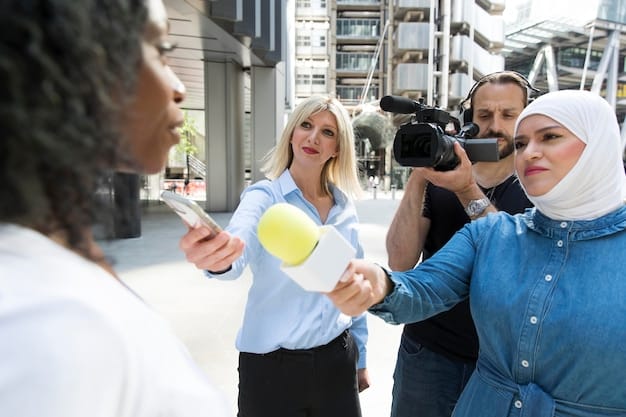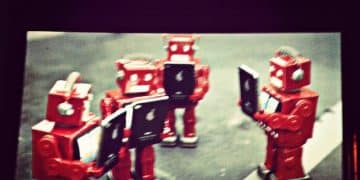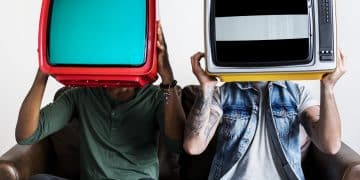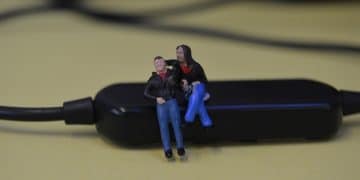Cable Originals: TV Shows Sparking Social Commentary

Cable Originals and Social Commentary: Shows That Spark Important Conversations often tackle complex societal issues, sparking crucial discussions and raising awareness among viewers, influencing perspectives and fostering a more engaged, informed society.
Cable Originals and Social Commentary: Shows That Spark Important Conversations are reshaping television. Beyond entertainment, these shows delve into pressing social issues, prompting dialogue and challenging norms.
Cable TV’s Role in Social Discourse
Cable television has evolved into a powerful platform for social commentary. This section explores how cable originals address sensitive issues, influencing public perception and fostering discussions around crucial topics.
The Evolution of Cable TV
Cable TV’s journey from simple entertainment to social commentary is significant. How did this shift occur?
Initially, cable channels offered viewers an alternative to network television, focusing on specialized content and niche audiences.
Over time, cable networks began producing original content, pushing creative boundaries and attracting diverse talent.
- Creative Freedom: Cable channels often allow creators more freedom to explore controversial or unconventional topics.
- Niche Audiences: Cable programming can cater to specific demographics, addressing issues relevant to those groups.
- Long-Form Storytelling: Cable shows often utilize longer seasons and complex narratives to delve deeper into social issues.
Cable’s willingness to take risks has made it a breeding ground for socially relevant storytelling. The landscape is changing and audiences are becoming more engaged with the content they consume.
Shows Tackling Race and Identity
Many cable originals confront issues of race and identity head-on. This section examines shows that tackle these complex topics through nuanced storytelling and compelling characters.
“Atlanta” and the Black Experience
“Atlanta” stands out for its unique portrayal of the Black experience in America. How does it achieve this?
The show explores issues of race, poverty, and cultural identity with humor, surrealism, and unflinching honesty.
“Atlanta” avoids stereotypes, presenting complex characters with relatable struggles and aspirations.
- Authenticity: The show’s authentic portrayal of Black culture resonates with viewers.
- Social Critique: “Atlanta” offers pointed commentary on systemic racism and social inequality.
- Artistic Vision: Donald Glover’s artistic vision sets “Atlanta” apart as a groundbreaking work of television.
“Pose” and LGBTQ+ Representation
“Pose” breaks new ground in its representation of LGBTQ+ characters, particularly those from marginalized communities. What makes its representation so impactful?
“Pose” celebrates the lives and culture of the ballroom scene in 1980s New York City, a safe haven for LGBTQ+ individuals.
The show features a diverse cast, telling stories of resilience, love, and community in the face of adversity.
- Authenticity: “Pose” features trans actors in trans roles, lending authenticity to the storytelling.
- Visibility: The show increases visibility for LGBTQ+ individuals, promoting understanding and acceptance.
- Historical Context: “Pose” sheds light on the AIDS crisis and other challenges faced by the LGBTQ+ community.
Shows like “Atlanta” and “Pose” push boundaries and challenge viewers to confront uncomfortable truths. Their impact extends beyond entertainment, promoting empathy, understanding, and social change.
Exploring Gender and Sexuality on Cable
Cable originals are at the forefront of exploring gender and sexuality, offering nuanced portrayals and challenging traditional norms. This section delves into shows that redefine these critical areas.
“Orange Is the New Black” and Female Identity
“Orange Is the New Black” provides a complex look at female identity within the confines of a women’s prison. How does it challenge stereotypes?
The show explores issues of race, class, and sexuality through a diverse cast of characters, each with unique stories and perspectives.
“Orange Is the New Black” humanizes incarcerated women, challenging viewers to question their assumptions about crime and punishment.
- Intersectionality: The show examines the intersection of gender with other aspects of identity, such as race and class.
- Character Depth: Each character is developed with depth and complexity, avoiding simplistic portrayals.
- Social Commentary: “Orange Is the New Black” critiques the criminal justice system and its impact on marginalized communities.
“Orange Is the New Black” provides viewers with a window into a world rarely seen on television, promoting empathy and understanding for incarcerated women.

Dystopian Visions and Political Commentary
Cable has embraced dystopian narratives as powerful vehicles for political and social commentary. This section examines shows that use bleak futures to comment on contemporary issues.
“The Handmaid’s Tale” and Women’s Rights
“The Handmaid’s Tale” offers a chilling vision of a totalitarian society where women’s rights are stripped away. How does it resonate with contemporary audiences?
The show explores themes of reproductive rights, religious extremism, and government control, drawing parallels to real-world issues.
“The Handmaid’s Tale” serves as a cautionary tale, reminding viewers of the importance of defending fundamental freedoms.
- Relevance: The show’s themes resonate with ongoing debates about gender equality and human rights.
- Emotional Impact: “The Handmaid’s Tale” evokes strong emotions, prompting viewers to reflect on the fragility of democracy.
- Visual Symbolism: The show’s striking visuals reinforce its powerful message about oppression and resistance.
“The Handmaid’s Tale” engages in conversations about crucial social issues. It forces viewers to confront uncomfortable truths about power, control, and the human spirit.
Comedy as a Tool for Social Change
Comedy can be a powerful tool for social change, and cable originals have embraced comedic storytelling to address serious issues. This section explores how humor is used to spark conversations and challenge norms.
“Black-ish” and Family Discussions
“Black-ish” uses humor to explore issues of race, identity, and social justice within the context of a Black family. How does it facilitate important conversations?
The show tackles topics such as police brutality, cultural appropriation, and the Black Lives Matter movement.
“Black-ish” provides a platform for open and honest discussions about race, while also entertaining and engaging viewers.
- Relatability: The show’s focus on family dynamics makes its social commentary relatable to a broad audience.
- Humor: “Black-ish” uses humor to make difficult topics more accessible and engaging.
- Education: The show educates viewers about Black history, culture, and current events.
Comedy has proven to generate important dialogue. These shows utilize humor to address crucial issues.
Mental Health and Personal Struggles
Cable originals are increasingly exploring mental health and personal struggles, offering nuanced portrayals of individuals navigating these complexities. This section delves into shows that humanize mental health challenges.
“Mr. Robot” and Social Anxiety
“Mr. Robot” offers a unique perspective on social anxiety and mental illness through its protagonist, Elliot Alderson. How does it portray these struggles?
The show explores Elliot’s battles with depression, paranoia, and social isolation, offering insight into the challenges of living with mental illness.
“Mr. Robot” avoids sensationalizing mental illness, presenting it as a complex and often debilitating condition.
- Authenticity: The show’s portrayal of mental illness is informed by real-life experiences and research.
- Empathy: “Mr. Robot” fosters empathy for individuals struggling with mental health challenges.
- Destigmatization: The show contributes to destigmatizing mental illness, encouraging open and honest conversations.
“Mr. Robot” increases awareness about mental health issues. These shows promote empathy and understanding.
The Future of Social Commentary on Cable
As cable continues to evolve, its role in social commentary is likely to grow even more significant. This section looks ahead to the future of socially relevant storytelling on cable television.
Trends in Storytelling Innovations
What trends are shaping the future of social commentary on cable?
Increased diversity, more realistic characters and the willingness to push boundaries
- Diversity: Cable originals will likely continue to diversify their casts and storylines, reflecting the diversity of the real world.
- Interactivity: Interactive storytelling and virtual/augmented reality may offer new ways to engage audiences with social issues.
- Global Perspectives: Cable shows may increasingly explore global issues and perspectives, fostering cross-cultural understanding.
The fusion of entertainment and advocacy has never been more prominent. The opportunity for cable originals to inspire change remains high.
| Key Point | Brief Description |
|---|---|
| 💬 Social Discourse | Cable TV’s role in sparking important social conversations. |
| 🎭 Identity | Exploration of race, gender, and sexuality in cable originals. |
| 🗳️ Political Commentary | Dystopian narratives and their political commentary. |
| ❤️ Mental Health | Shows addressing mental health and personal struggles. |
Frequently Asked Questions
▼
Cable channels often have fewer restrictions than broadcast networks, allowing creators to explore controversial and nuanced topics more freely, resulting in more impactful social commentary.
▼
By presenting diverse characters and storylines, cable shows can challenge stereotypes, promote empathy, and raise awareness about social issues, ultimately shaping public opinion and fostering a more understanding society.
▼
Yes, comedy can be a powerful tool for social change. It can make difficult topics more accessible, engage broader audiences, and spark conversations about important issues in a lighthearted yet meaningful way.
▼
Diversity is crucial, because diverse casts and storylines offer a wider range of perspectives and experiences, helping to challenge dominant narratives and promote inclusivity and representation in media.
▼
Cable shows are increasingly portraying mental health issues with authenticity and nuance, aiming to destigmatize them, raise awareness, and foster empathy and understanding towards individuals struggling with these challenges.
Conclusion
Cable Originals and Social Commentary: Shows That Spark Important Conversations have redefined television. These shows offer a platform for dialogue and thought-provoking debate on a range of topics. By pushing boundaries and challenging norms, cable TV is poised to continue offering a unique space for conversations about critical issues, reminding us of the power of television to inspire change.





